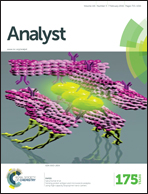AnalystAssociate Editor,Professor Jean-François Masson(Université de Montréal,Canada) has selected his Top 5 articles published in the field of sensing and clinical assays in recent issues ofAnalyst.
Professor Masson is Professor in the Department of 新利手机客户端Chemistry of the Université de Montréal.His research areas are sensing using plasmonic techniques,surface 新利手机客户端chemistry,metallic nanomaterials and portable instrumentation design for sensing of biomolecules and drugs in crude biofluids for improved clinical assays.
Read what Professor Masson's Editor's Choice thinks about the Top 5 he has selected below– all articles arefree to accessfor the next 4 weeks!
Tanja Gaissmaier et al.,Analyst,2016,141,892,DOI:10.1039/C5AN02302E
Therapeutic drug monitoring is increasingly performed to ensure safe usage of drugs for the treatment of medical conditions.The analysis of dried blood samples is an interesting approach for rapid and minimally invasive clinical assays and for forensic 新利手机客户端sciences.In this study,the authors report microjunction sampling of dried blood spots in conjunction with mass spectrometry for different therapeutic drugs.This method showed lower limits of detection than comparable techniques and it was applied to the analysis of blood samples from donors,providing a proof-of-concept of actual use of this technique in clinical laboratories.
Huashan Wanget al.,Analyst,2016,141,815,DOI: 10.1039/C5AN01835H
The detection of testosterone is of importance in sport doping and in clinical 新利手机客户端chemistry.However,the detection of testosterone is often challenging.The authors propose a microfluidic device for detecting testosterone in serum and urine samples with an indirect chemiluminescence assay.The authors applied the optimized assay for the analysis of a series of human serum samples.They went one step further with the comparison of the results obtained with their assay with two commercial ELISA kits.The authors confirmed that their technique was in good agreement with the current state-of-the-art,an important step in the validation of a new method.
Microchip-based electrochemical detection using a 3-D printed wall-jet electrode device
Akash S.Munshi and R.Scott Martin, Analyst,2016,141,862,DOI:10.1039/C5AN01956G
3-D printing is changing ways of prototyping and fabricating industrial devices.Recently,a few articles introduced 3-D printing in analytical 新利手机客户端sciences for the fabrication of detectors and fluidic devices.In this article,the authors go a step further with the application 3-D printing method for the fabrication of an electrochemical microfluidic cell with a wall-jet electrode.The authors report an improved detection limit with this device in electrochemical experiments and they integrated the electrochemical microfluidic unit as a detector in HPLC.This study demonstrates the usefulness and advantages of 3-D printing in analytical prototyping.
Determination of the ratio of fluorophore/ nanoparticle for fluorescence-labelled nanoparticles
Mario Menendez-Mirandaet al.,Analyst,2016,141,1266,DOI:10.1039/C5AN02405F
While nanoparticles modified with fluorophore are now commonly used in sensing or in imaging techniques,their characterization remains challenging.In this article,the authors propose a general method addressing the current limitations for purification and characterization of the fluorophore-nanoparticle conjugate.They purified several fluorophore-nanoparticle conjugates with centrifugation and electrophoresis and then applied UV-Vis and ICP-MS to characterize the fluorophore to nanoparticle ratio for a series of nanoparticles modified with different fluorophores,demonstrating the broad applicability of their method.This technique will be useful to the large community of researchers designing new fluorescent nanoparticles.
Ankita K.Parmaret al.,Analyst,2016,141,1488,DOI:10.1039/C5AN02303C
The application of nanoplasmonics in clinical 新利手机客户端chemistry is increasingly proposed to provide rapid and sensitive clinical tests.However,validation of nanoplasmonics in clinical samples remains relatively rare.In this study,the authors showed a nanoparticle aggregation assay for creatinine working in diluted blood and cerebrospinal fluids.The Ag nanoparticles were modified with picric acid for the selective detection of creatinine.The selectivity was shown with a series of 29 small molecules and 8 common ions.The results obtained with this technique were in good agreement with the current test for creatinine.This article reports on an example of the application of nanoplasmonics for targeted detection of a molecule of clinical interest in biofluids.












